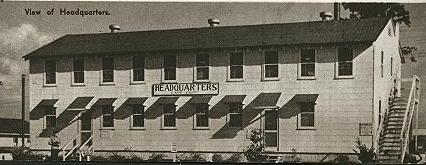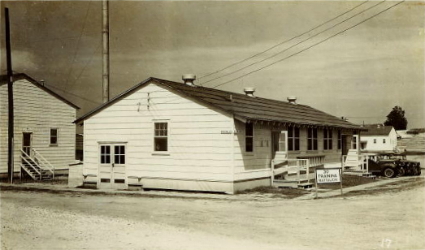|
Camp Headquarters
|
4th
Service Command and the Army Service Forces
At the outbreak of W.W.II the United States Army organized the Army
Service Forces. Within that Army Service Forces there were nine
Service Commands. The 4th Services Command Headquarters was in
Atlanta, Georgia which encompassed the 4th Corp area also known as the
4th Service Command. North Carolina, South Carolina, Georgia,
Florida, Alabama, Tennessee, Mississippi, and Louisiana were under this
command. The Commanding Officer of the 4th Service Command
was Major General Henning.
The Service Commands under the direction of the Army Service Forces was
commanded by Lt. General Brehon B. Somervell and consisted of 1,569,000
men
and played a vital part in the successful prosecution of the war.
They
were responsible for supply, equipping and movement of troops both at
home
and overseas; for food, clothing, equipment, ammunitions, and medical
services;
for the road, rail and sea transportation; for personnel record and
mail
service. In addition they ran the military bases, coordination of
the
military ammunitions productions in the continental US, and the actual
issue
of weapons. They were also responsible for the steady stream of
supplies
to all theaters of war; in addition they provided educational programs,
films
and newspapers to the troops. Their supply lines extended over
56,000
miles and they had the authority over seven technical services, eight
administrative
services and nine service commands, six ports of embarkation, and nine
general
depots.
The design of the 4th Service Command shoulder insignia was arbitrarily
selected to represent the 4th Corps Area Service Command. White,
being
a mixture of all colors, was selected for the reason that Corps Area
Service
Commands may be composed of all arms and services. The geometric design
represents the Command's numeric designation.

At Camp Croft, the
Post Headquarters were administratively attached
to the Fourth Service Command.
|
|
|
|
IRTC
Headquarters
|
 On
04SEP42 the IRTC and Station Complement (Post
HQ) were designated as separate commands. On
04SEP42 the IRTC and Station Complement (Post
HQ) were designated as separate commands.
|
|
26th
Battalion
8th Regt.
|
Headquarters - The 26th ITB, assigned to
the 8th Regiment, was the only group assigned to train men for
functions within a headquarters company. From 19OCT43 to 20MAR44 the
battalion was detached from the 8th Regiment and designated a separate
command. |
|
27th
Battalion
8th Regt.
|
Service - The 27th Battalion trained men
to become members of a service company and consisted of Co. A - motor
mechanics, Co. B - chauffeurs (truck drivers), Co. C - pioneers and
clerks, and Co. D - cooks, armorers-articifers and buglers. From
19OCT43 to 20MAR44 the battalion was detached from the 8th Regiment and
designated a separate command. Co. E and F were made up of
African Americans and attached administratively to the 10th Regiment on
16JUL42
(see also 49th ITB).
Click here to view a 1942
history of this unit
The story of Co. E and F can be found in the 50th
ITB history
|
|
28th
Battalion
8th Regt.
|
Anti-tank - Men of the 28th ITB trained
exclusively as anti-tank company members. Their motto was "The Quick
and the Dead". The battalion was initially assigned to the 8th
Regiment, transferred to the 9th on 16JUL42, and back to the 8th on
20MAR44.
Click here to view a 1942
history of this unit
|
|
29th
Battalion
9th Regt.
|
Heavy Weapons - The 29th ITB was one of
the three battalions assigned to the 9th Regiment that provided
training for Heavy Weapons Company trainees. Each of the HW battalions
were assigned to the 8th Regiment before the creation of the 9th
Regiment on 20OCT41.
Click here to view a 1942
history of this unit
|
|
30th
Battalion
9th Regt.
|

Heavy Weapons - The 30th ITB was one of
the three battalions assigned to the 9th Regiment that provided
training for Heavy Weapons Company trainees. Each of the HW battalions
were assigned to the 8th Regiment before the creation of the 9th
Regiment on 20OCT41.
Click here to view a 1942
history of this unit |
|
31th
Battalion
9th Regt.
|
Heavy Weapons - The 31st ITB was one of
the three battalions assigned to the 9th Regiment that provided
training for Heavy Weapons Company trainees. Each of the HW battalions
were assigned to the 8th Regiment before the creation of the 9th
Regiment on 20OCT41.
Click here to view a 1942
history of this unit
|
|
32nd Battalion
6th Regt.
|
Rifle - The 32nd ITB was
originally assigned
to the 7th Regiment and later transferred to the 6th (on 20OCT41). |
|
33rd Battalion
6th Regt.
|
Rifle - The 33rd ITB was also originally
assigned to the 7th Regiment and later transferred to the 6th (on
20OCT41) . On 07MAR41 the 33rd
had the distinction of being the first battalion activated at Croft. |
|
34th Battalion
6th Regt.
|
Rifle - The 34th ITB was another of the
battalions originally assigned to the 7th Regiment and later
transferred to the 6th. |
|
35th
Battalion
6th Regt.
|
Rifle - The 35th ITB, like the 32nd, 33rd,
and 34th, was originally assigned to the 7th Regiment and later
transferred to the 6th |
|
36th
Battalion
7th Regt.
|
Rifle - The 36th ITB was assigned to the
7th Regiment, transferred to the 6th (on 20OCT41), and later
transferred back to the 7th (on 16JUL42). |
|
37th
Battalion
7th Regt.
|
Rifle - The 37th Battalion was assigned to
the 7th Training Regiment. |
|
38th
Battalion
7th Regt.
|
Rifle - The 38th Battalion was assigned to
the 7th Training Regiment. |
|
39th
Battalion
7th Regt.
|
Rifle - The 39th Battalion was assigned
to the 7th Training Regiment. |
|
40th
Battalion
7th Regt.
|
Rifle/Special Training - The 40th ITB was
originally assigned to the 7th Regiment but on 16JUL42 began reporting
directly to IRTC Headquarters as a "Special Training Unit". By 9AUG43
it was again assigned to the 7th and continued training men for Rifle
Company duty.
To view the 15OCT41 issue of the "40th Column," a newspaper published
by
the
Battalion, click here. |
|
41st
Battalion
9th Regt.
|
Rifle - The 41st ITB had a short history,
having been created and assigned to the 9th Regiment on 13MAR44. |
|
49th
Battalion
10th Regt.
|
Service - The 49th ITB was the second
battalion made up of Africa American selectees. It was activated on
16JUL42 and inactivated on 15JAN44. Company E and F of the 27th were
assigned to the battalion and redesignated Company A and B respectively. |
|
50th
Battalion
10th Regt.
|
Rifle - The 50th ITB was one of the
original training battalions and made up entirely of African American
selectees. Known as a "colored" battalion, members trained for Rifle
Company duty. The unit was assigned to
the 7th (20MAR41), 9th (20OCT41), and finally the 10th (18APR42)
Training Regiments. Like the 49th, this battalion was inactivated on
15JAN44.
Click here to view a 1942
history of this unit
|
|
71st
Battalion
|
The 71st Battalion was activated on 19APR43 as
part of the 6th Regiment but shortly afterwards designated as a
separate command. No permanent quarters were available so the battalion
was housed in tents. On 02NOV43 the three companies of the battalion
were redesignated as the 230, 231, and 232 Replacement Companies.
The three companies of the 71st Replacement Battalion were
attached to Headquarters, United States Army Northern Ireland Force
(USANIF) and stationed for a time in Northern Ireland - the 230th at
Coleraine Sub Port until 19APR44, the 232d at Dogleap until 29APR44,
and the 231st at an unknown location and date. |
|
Women's
Army Corps (WAC) Detachment
|
For the first three
years of the camp's existence, Croft was staffed with only male
military personnel, the only exception being nurses in the station
hospital. In January 1944, a Women's Army Corps (WAC) detachment was
organized and assigned to duties in the hospital, replacing men who had
performed the same tasks. This first contingent of WACs served
primarily as administrative and clerical staff, although at times they
were assigned to duty in the hospital wards as nurse's aides as well as
duties outside of the hospital. Less than four months later, on 8 APR
44, a second detachment
was organized for administrative work in the IRTC headquarters. By
November 1944, the IRTC detachment was disbanded only to be reorganized
in March 1945 and remained in place until October after news was
released that the camp would soon close. Aside from their efficient
execution of numerous and varied tasks, a very important part of the
WACs role was to replace able bodied men who were needed for overseas
assignments. The women also staffed WAC recruiting booths in town,
encouraging young Spartanburg women to join their ranks. |
|
Field
Artillery Detachment
|
In
1943, in
continuing efforts to make stateside training more realistic, the Army
prescribed overhead and flanking artillery fire to be used while
trainees navigated IRTC battle courses. Probably in an effort to
provide this supporting fire, the camp activated a Field Artillery
battalion 20 DEC 44 but, by 12 JAN 45, it was discontinued and absorbed
into the IRTC headquarters. Artillery training was not part of Croft's
curriculum but many soldiers recall demonstrations and the presence of
large caliber unexploded ordnance in what was once the camp's training
areas proves the use of Field Artillery at the camp. |
|
Ordnance
Service
Command Shop
|
|
162d and 163d
Army Bands
|
Camp Croft's 1st
IRTC Band was designated the 162d Army Band and the 2nd IRTC Band was
also known as the 163d Army Band. In 1944, Army regulations called for
separate bands to consist of 28 men and one warrant officer who acted
as the band director. A third band, made up of African American
soldiers, was formed and known as the 3rd IRTC Band.
|
|
Post
Photographic Laboratory
|
|
|
Station
Hospital
|
The Station Hospital was organized on 10FEB41. Click here to view the program from the
Organization Day 2nd Anniversary celebration.
For a short period of time, the 319th Station Hospital was at Croft
prior to their deployment in Europe.
|
|
1405th
SCU: Armed Forces Induction Station
|
In
August
1942, the 1405th Station Complement Unit (SCU) Induction Center opened at
Camp Croft when 18
recruits from nearby Polk County, North Carolina were received for
initial processing. Larger groups followed as the center processed
thousands of men, mostly from Western North Carolina, for induction
into the Army. The procedure was brief, a physical examination followed
by administering of the oath of enlistment, after which the men were
offered a two week unpaid furlough before being sent to the Fort Bragg
Reception Center for further processing. The Induction Center
facilities and
54-person staff were entirely separate from the IRTC and included
barracks, a mess hall, and an examination building. According to
existing induction center records, 61,872 men were processed at the
Croft Induction Station, 86% of whom were from North Carolina.
|
|
1454th
SCU: Station Complement
|
|
| Navy
Recruiting Sub-Station |
Obviously not a part
of the Army Command structure, however, the Navy also had a small
presence at Camp Croft. A recruiting and induction station was
set up in early 1943 and accepted inductees from Western North
Carolina for service in the Navy, Marines, and Coast Guard. Navy
recruits were usually sent to the Bainbridge, Maryland training station.
|